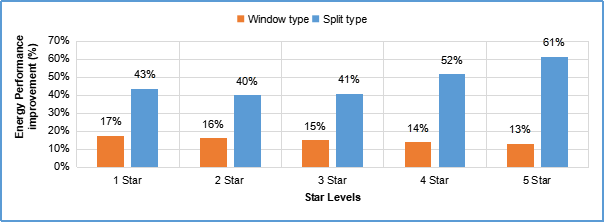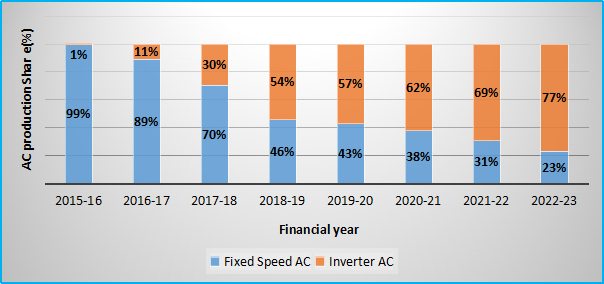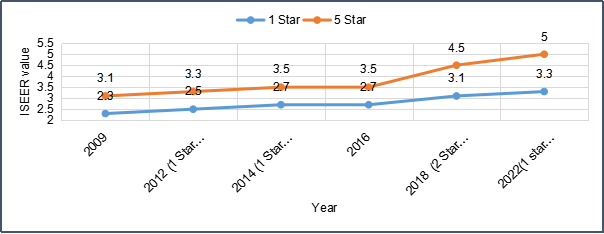India’s energy efficiency policies have not only led to improvement in overall energy efficiency of Air-Conditioners but also accelerated the deployment of highly Energy Efficient inverter technology. As per the data from the Bureau of Energy Efficiency (BEE), Ministry of Power, for split Room Air-Conditioners (RACs), the overall energy efficiency improvement is 43% for 1-Star and 61% for the 5-Star level. On the other hand, the overall energy efficiency improvement for window RACs is 17% for 1-Star and 13% for 5-Star level.
Figure 1: Improvement in 1 Star and 5 Star for Window and Split ACs

The interventions by the Central Government have also led to increase in the market share of the more efficient, Inverter RACs. In 2015, the market share of variable speed (commonly known as inverter) RACs was less than 1% in the overall RAC market size of 4.7 million units. In June, 2015, BEE introduced a voluntary labelling program for Inverter RACs with a new star rating methodology called Indian Seasonal Energy Efficiency Ratio (ISEER) which was made mandatory from January 2018.
During the eight years from 2015-16 to 2022-23, the market share of the more efficient, variable speed (Inverter) RACs increased from 1% to 77%, while that of the fixed speed RAC, reduced from 99% to 23% during the same period. The overall market for RACs reached 6.6 million units by 2020-21. This market transformation towards efficient technology was possible due to adoption of variable speed (Inverter) RAC policy, which offers benefits to the consumers in terms of electricity and cost saving.
Figure- 2: Market Transformation of Fixed speed and Variable Speed RAC

These interventions are part of the India Cooling Action Plan (ICAP), which aims to provide an integrated vision towards cooling across sectors encompassing inter alia reduction of cooling demand, refrigerant transition, enhancing energy efficiency and better technology options with a 20-year time horizon.
Responding to the progress made in implementation of the Star Labelling program, Shri Alok Kumar, Secretary, Ministry of Power said that program is achieving its intended outcomes. He added that the Indian economy is growing at a rapid pace and so the demand for cooling is going to increase multi-fold over next few decades. Under ICAP, a detailed action plan has been chalked out. This will ensure that while we cater to our development needs, we do it in an efficient manner. Shri Abhay Bakre, DG, BEE said that the ICAP is a comprehensive plan covering all sectors and the government is committed to successfully implementing the ICAP.
BEE has been revising the star rating plans for split and window RACs to increase the stringency of the energy performance thresholds, as shown in Table – 1 and Table – 2 respectively.
Table 1: Revisions in star ratings plans for split type RACs
| Star level | Jan 2009- Dec 2011 | Jan 2012- Dec 2013 | Jan 2014-Dec 2017 | Jan 2018- June 2022 | July 2022-Dec 2024 |
| 1 star | 2.3 | 2.5 | 2.7 | 3.1 | 3.3 |
| 2 star | 2.5 | 2.7 | 2.9 | 3.3 | 3.5 |
| 3 star | 2.7 | 2.9 | 3.1 | 3.5 | 3.8 |
| 4 star | 2.9 | 3.1 | 3.3 | 4.0 | 4.4 |
| 5 star | 3.1 | 3.3 | 3.5 | 4.5 | 5.0 |
As per Table 1, the extent of efficiency improvements for the split type RACs have seen frequent and substantial revisions, in comparison to window RACs due to technological and size constraints (see Table – 2). The improvement made in the efficiency values (ISEER) for split RAC is presented below at Figure 3.
Figure3: Improvement in 1 Star and 5 Star for Split ACs

Table 2: Revisions in star rating levels for window/unitary type RACs
| Star level | Jan 2009- Dec 2013 | Jan 2014 – June 2022 | July 2022 – Dec 2024 |
| 1 star | 2.3 | 2.5 | 2.7 |
| 2 star | 2.5 | 2.7 | 2.9 |
| 3 star | 2.7 | 2.9 | 3.1 |
| 4 star | 2.9 | 3.1 | 3.3 |
| 5 star | 3.1 | 3.3 | 3.5 |
Be First to Comment